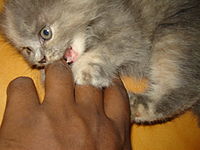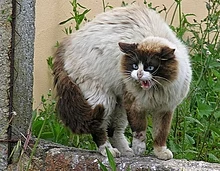Aggression, such as hostile or violent behavior meant to dominate or intimidate, can become a real problem with cats. Causes of this behavior in cats can be complex, both in terms of triggers and targets. So, how can you deal with aggressive cat behavior problems?
Start by being aware of the signs of a fearful or aggressive cat. These signs might include: dilated pupils, ears flattened backward on the head, tail erect with the hairs raised, and the back arched.
A cat may display one or more than one type of aggression. These responses in a cat in the wild developed as an essential for their survival as territorial predators who are self-reliant. Though aggression can be normal or abnormal, depending on context, in general its root cause has to do with the cat’s self-preservation instinct and its fearfulness.
Several forms of aggression may cause the same response, such as growling, swiping, scratching, and sometimes using teeth and claws. Thus, it could take some time to classify the type of aggression the cat displays.
Classification of Aggression
Aggression Toward Humans
Such aggression usually relates to felines living in the home. They might come about while the cat is being handled or petted. One study indicates that cats showing aggression do so more often against children or women.
One cause of such aggression occurs due to premature weaning. Kittens not weaned by their mothers may not learn how to handle frustration.
If the cat becomes aggressive toward people, he needs to undergo a vet examination with detailed history, and then the vet’s evaluation. Courses of action will vary, depending on the situation.
Look at these six main reasons for aggressive behavior toward humans:
1) Aggression based on fear
Some cats show more fearfulness than others because of poor human socialization during their sensitive kitten stage (2 to 8 weeks.) When confronted with a new experience, such as a new pet in the home, unfamiliar or unpleasant situations, and negative experiences, the cat reacts out of fear.
If a cat feels threatened, he may exhibit defensive behavior when approached. His responses might include crouching, flattened ears, raised fur, or vocal warning.
Do not try to comfort your cat physically when he shows signs of fear. It could lead to your being injured and it might escalate into kitty panic.
Your cat should have lots of hiding places, and forced contact with new people or pets should be avoided until you can find a way to diminish his fearfulness.
2) Play/Predatory Aggression
These include pouncing on and attacking their human’s hands and feet. Often the cause can stem from one’s playing with kittens using the hands. The kitten becomes over-stimulated and the human does not take steps to curb this behavior.
If left with the mother until weaned, she will teach the kittens to soften their play. An adult cat who plays too aggressively with people has not been taught as a kitten to restrain this response.
Teach kittens to play appropriately from a young age by redirecting them to an inanimate object, such as a ping pong ball or a wand and string with a toy on the end that the cat can chase.
ball or a wand and string with a toy on the end that the cat can chase.
Enrich your cat’s environment with daily play sessions. Provide climbing and exploring choices and problem-solving opportunities, and do these outside if possible.
Avoid punishing the cat. Instead, remain calm and unresponsive in the face of unwanted behavior. Then walk away, so you do not reinforce this inappropriate behavior.
3) Aggression Induced By Petting
Some cats ask for your attention and then unexpectedly stop the interaction by biting and scratching. The cat wants social contact, but does not like intense interaction such as stroking in several places over his body or petting with a heavy hand. Many cats enjoy gentle stroking, but don’t want it to be too intense.
The cat might also become conflicted between pleasure and danger, and if he becomes too relaxed, he may feel the need for immediate escape because of his instinctive survival mechanism.
Watch for subtle warning signs if the cat becomes highly agitated. With this kind of cat, stay away from extended petting sessions, especially on belly, chest, or back, where he feels most vulnerable.
4) Aggression Induced By Pain
If your cat has an illness, he may have a lower pain threshold, and may lash out because of it. Look for warning signs that he might be upset. Some illnesses that can cause this aggressive response include degenerative joint disease, hyperthyroidism, dental problems or neurological disorder.
Consult your vet and use pain control methods and the complementary therapies. Avoid touching painful spots on his body.
5) Redirected Aggression
When the cat becomes frustrated or agitated by something and cannot achieve his desired outcome, he may redirect his aggression toward someone near the source of his upset. This redirection could be toward a human or toward another cat.
A typical cause could include seeing another cat from the window that he can’t chase off, or when the owner picks up a cat while he is in the midst of a cat fight.
cat while he is in the midst of a cat fight.
My mother suffered an attack from a cat who loved her dearly. However, he had gotten out and got in a fight with an intruder. My mother came up behind him and picked him up. Her cat immediately attacked her, being aroused to fighting mode and not realizing who he attacked. He just knew someone grabbed him, and he lashed out.
He slashed her arm, cutting an artery, and blood gushed from the wound. Fortunately, my dad came to her aid, putting her into the car and heading for the hospital emergency room, moving fast down the road.
A policeman stopped him. When my dad explained the situation, the policeman gave him an escort, traveling in front with sirens blaring. They got there in nothing flat.
This injury could have been prevented if my mother had found a way to remove the cause of his upset. Perhaps a bucket of water on the intruder, or a broom to separate them.
A frightened animal or one in full fighting mode can cause agitation, resulting in an unwanted attack.
6) Maternal Aggression
A mother cat can become very ferocious if she feels her babies are threatened. She could show this aggression toward humans or other animals.
To minimize the problem with this type of aggression, keep guests who want to see the kittens to a minimum. Give Mama Kitty a quiet, stress-free place for her and her babies.
Try to minimize any nest scent disruption. That spot needs to smell like mama and her babies. Observe the queen’s behavior when anyone handles her kittens to make sure she can accept their presence.
Inter-Cat Aggression
Such aggression becomes triggered by the presence of another cat. Felines tend to be solitary, and will often not accept a newcomer easily.
To prevent such conflicts between cats, introduction of a new cat should be gradual. Get them used to each other slowly, and if hostilities develop, keep them apart until they become accepting of one another.
Put a blanket with the other cat’s scent in the newcomer’s bed, and share something smelling like this newcomer with the resident cat. Use pheromone products to help minimize hostility.
If a cat suddenly becomes aggressive, it is often an indication of a disease or medical condition. Your vet becomes a valuable ally in helping you understand what causes the cat’s behavior.
Realize that fear or pain might cause the problem, and try to get to the bottom of these issues.
Causes Of Aggression
As you can see, the causes could come from many sources. Sometimes the cat is born with an aggressive personality type. Or, if the cat had no human contact before the age of three months or has not had social interaction with other cats, the kitty does not know how to behave appropriately.
Play aggression is an important development stage for kittens. Their natural predatory behavior starts around 10 to 12 weeks of age, and will generally wind down on its own.
Fear can bring on aggression. If the cat becomes traumatized by unhealthy environments, such as shelters, cages, or over-crowded quarters, they can lash out aggressively.
over-crowded quarters, they can lash out aggressively.
This response becomes particularly true if the cat has been abused by animals or humans. Children often become rough with animals because they have not been taught that such behavior will not help the cat. If the cat becomes fearful because of a child, he may become aggressive with all children.
Normal aggression occurs if the cat feels the need for defensive behavior. A mother cat protects her kittens, and a father cat will do the same. Perhaps they stake out a certain amount of territory and then physically assert their domination of that territory.
Treatment
If an underlying disease causes the behavior, the vet can treat it. If the cat has no illness, it becomes up to you to retrain your cat. You will need to provide behavior modification techniques. You must change your attitude to encourage the change in your cat. Some modification training might include the following:
- Avoid frightening situations
- Do not provoke aggressive behavior
- Learn the situations which will cause a bad reaction from your cat
- Learn to read the signs that could mean the start of aggressive behavior
- Leave the cat alone when he is aggressive
- Reward good behavior, but when aggression signs show up, walk away and refuse to give kitty attention until the behavior changes.
- If dealing with aggression between cats, separate them and keep the aggressive one in a less-favored area.
- Use of leashes and harnesses, or perhaps clicker training to encourage desired behavior
Make behavior modification training sessions short to avoid resentment, boredom and resistance. Very Important: Do not use physical punishment of any kind, as this will only make the problem worse.
If your vet has assured you that he finds no medical reason for aggressive behavior, then try to identify the type of aggression. When you can identify the cause, you have a key to understanding its causes and developing a plan to change things.
These suggestions can help manage all types of feline aggression:
- Intervene early
- Do not punish, as it can increase a cat’s fear and anxiety and worsen aggression
- If used in combination with behavior and/or environment modifications, medications can help
- Startle an aggressive cat without physical contact, as this technique can often prove effective
- Avoid situations that you know make a cat aggressive
- Separate cats when they get aggressive toward each other, and reintroduce slowly with positive reinforcement
- Use food treats as positive enforcers of non-aggressive behavior
- If you cannot manage kitty’s aggression with these techniques, consult a veterinary behaviorist
When an aggressive cat appears to be in charge of the house, behave like an “alpha cat.” Let the cat know that you are in charge and not afraid. Act like a cat: Growl, as this means “watch out! I am angry.” You can also hiss, as a cat knows what a hiss means and will back off immediately.
Stand up when you use these sounds, as your size can help. If the cat misbehaves while you are sitting down, and you stand up and growl or hiss, you will definitely get the cat’s attention.
You can clap your hands to distract the cat, as long as this action will be associated with discipline only. Single-word commands work best, such as “stop,” “no,” or “off.” Do not yell, as the cat has a high sensitivity to the different tones of your voice. A shout comes off as slightly hysterical. Use a single-word command instead.
Apply these principles immediately, when the bad behavior is in progress. Then ignore the cat, rather than rushing to apologize, as this action would confuse the cat.
With patience and consistence, you can help your cat to avoid aggressive behaviors. Retraining the cat can be a challenge, but in the long run you have made a worthwhile effort that will help all parties involved.
References I used for this post:
catchat.org/index.php/cat-behaviour-aggression
allaboutcats.com/aggression-in-cats
petmd.com/cat/behavior/causes-sudden-aggression-cats
petmd.com/cat/conditions/behavioral/c_ct_aggression
Here are some products that may help if you have a cat with aggression problems. Click on the image or the blue-highlighted title to be taken to Amazon, where you can purchase. Please note: I will receive a small commission from your purchase.
Feliway MultiCat Pheromone Diffuser + 2 refills
Cat calming product – 60 day supply bundle
by A P Taber Store
Price: $54.99 + $5.72 shipping
Feliway Cat Calming Spray (60 ML)
#1 Vet Recommended Solution
by Central Garden & Pet
Price: $21.10 Prime
Sentry Calming Collar for Cats, 3 Ct., Purple
by Sergeant’s Pet Care
Price: $22.19 Prime




